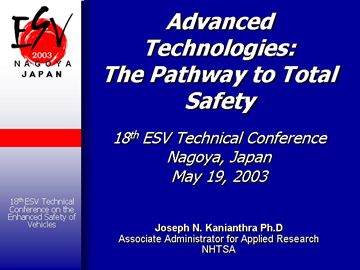
[Click on image to enlarge] |
Good afternoon, Distinguished Guests and
Fellow Delegates.
Thank you Mr. Wani for those kind words
of introduction. It is so good to see so many of you here, once again
at this ESV conference.
I congratulate Mr. Wani for organizing
this session. The topic of discussion is very timely especially because
of the advances in safety technologies that are taking place in automobiles
worldwide.
It is indeed a pleasure for me to participate
in this enlightening session. It is not often that we discuss futuristic
safety vision at ESV conferences.
|
|
I have chosen as the topic today, a discussion
of the role of advanced technologies in meeting the need for TOTAL SAFETY.
I have chosen 2030 as the time frame even though it may not be seen
as “the near future” to some.
The concept of TOTAL SAFETY is not new.
Dr.Tingval in Sweden espoused the concept of Zero fatalities several
years ago. I believe similar concepts are under consideration in other
jurisdictions as well.
|
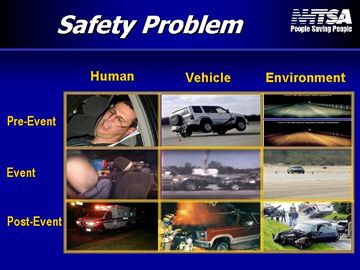
[Click on image to enlarge] |
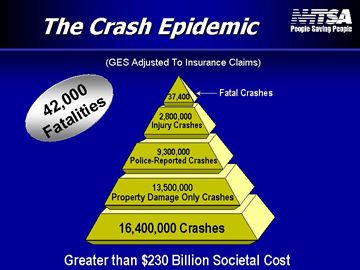
[Click on image to enlarge]
|
|
Every one of these cells represents many
different problems that we have to deal with in safety.
I need not elaborate the contents of each,
as all of us are only too familiar with these problems.
To give you a few examples, some injuries
and fatalities result because the vehicle did not provide adequate protection.
Others are caused by the roadway environment
or roadside hardware.
The failure of a vehicle to respond to
drivers’ demands as in braking and the failure of drivers to keep vehicles
under control for other reasons, also cause crashes.
Drivers themselves are at fault in many
instances because of impairment or failure to use the restraint systems
that are available in vehicles.
However, one difference must be noted here.
Before many new technologies found their way in to vehicles, the problems
depicted in these cells could have been treated as unique problems independently
in finding solutions.
That is not the case any more. They are
interlinked much more now than one would imagine. That means- in finding
solutions for one, we must consider its impact on another.
Total Safety is achieved when we can eliminate
the casualties that result due to the problems laid out here
I am using here our own data in the United
States for illustration purposes.
As many of you already know, the total
safety need is staggering. Our early assessment data estimates that
in 2002, 42,850 lives were lost as a result of motor vehicle crashes.
We have nearly 6.4 million police reported
crashes, annually. Counting the non-reported crashes, the total crashes
number about 12 million. Adjusted numbers based on insurance claims
are even higher at 16 million.
The economic burden of this problem is,
thus, over $ 230 billion U.S. Dollars.
|
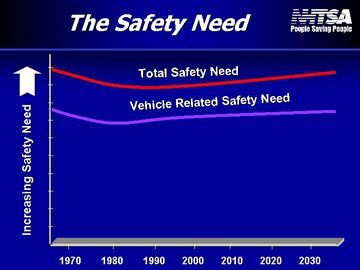
[Click on image to enlarge]
|
It is clear our goal should be TOTAL SAFETY.
What I have shown in this slide are two
lines - one representing the total safety need and the other the part
of the total need represented by all aspects other than the roadway
environment
They are hypothetical lines even though
they have some resemblance to reality. I have chosen the time period
between 1970 and 2030 for discussion so that we can look at the past
and look ahead to the future.
These lines could be representing number
of crashes, total fatalities or total injuries.
|
|
As we look at the fatality trend in the
United States, we see that there was a decline from over 50 thousand
killed in the 1960’s to about 40 thousand in the 1990’s with small fluctuations
in the intervening period.
However, we can expect these numbers to
creep back up again very slowly. We know that the number of vehicles
and the miles traveled are increasing. There is population growth.
Registered vehicles in United States have
doubled from 1970 to 2001.
Naturally, increased demand for personal
transportation will increase the exposure. If nothing is done, this
will lead to increases in crashes and the resulting casualties.
So it is not surprising that there is this
increasing demand for safety and you can expect this trend to continue
in to the future in the absence of new initiatives.
As safety improvements occur in vehicles,
one would expect the demand for safety would be met.
However, note that those improvements may
not come fast enough to meet the total need.
The gap between these two lines will thus
show a widening trend
|
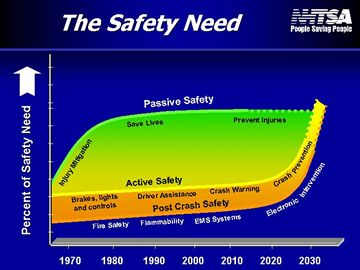
[Click on image to enlarge]
|
Let us now look at what we have been doing
to meet the demand for safety.
Our efforts for the last so many years
have been concentrated mostly on passive safety.
Given a crash, we had to find ways to protect
the occupant. Therefore, it is not surprising that our efforts went
in that direction.
It is also a well-known fact that in the
last three decades, we have made tremendous strides in crash protection.
And we are continuing to search for even
more advanced technological solutions for better occupant protection.
|
|
The advances made in improving vehicle
crush characteristics, better crash energy management, improved restraint
systems including inflatable systems, and other occupant protection
countermeasures continue to contribute much to safety.
There have also been advances in braking,
lighting, vehicle control technologies, and other improvements both
in pre-crash and post-crash safety.
However, all of it taken together still
addresses only a part of the total safety need and leaves us with a
huge gap that we need to close to achieve total safety.
It is evident that the gap that exists
between the vehicle-related safety need and what is currently available
through passive, active and post-crash safety countermeasures leaves
us with a great deal of room for improvement.
It is also clear that
our focus on passive safety itself must change from injury mitigation
and saving lives to injury prevention. It is commendable that many
automobile manufacturers are already attempting to do that.
The efforts to improve
passive protection further will continue for the next decade with greater
emphasis on refinements of countermeasures that are already under development.
Pre-crash sensing, tailored
inflation air bags and injury prevention through improved and adaptable
belt systems such as variable pre-tensioning and load limiting would
likely emerge.
Even then, the incremental
benefits will be leveling off.
However, those approaches
that are lagging behind represented by the two lines at the bottom must
take a sharp turn upward to close this gap in the next two decades.
I contend that, worse
yet, this widening gap between the safety need and that would be available
through existing countermeasures would continue to grow.
And we have two decades
available to make major improvements in crash prevention technologies
for the design, development and deployment, provided the public would
find them acceptable.
The question then is
how can we accelerate the process for closing this gap?
I argue that some of
the major problems that exist need to be solved through advances in
safety technologies, new legislative approaches, collaborative research,
use of market pull and conventional and novel methods for safety standards
development.
I contend that through
our collective efforts it would be possible to achieve the desired results.
As the trend lines here
would indicate, if we continue our conventional approaches, that would
not fill this gap. And this is our challenge.
|
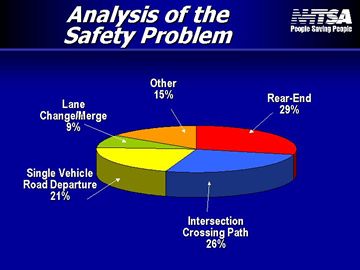
[Click on image to enlarge]
|
In the last several years NHTSA has attempted
to address this issue by developing active safety countermeasures tailored
to prevent crashes by using sensors, computers and communication devices.
This chart shows the breakdown of the various
crash types that make up the total number of police reported crashes
in our database.
Roughly 2 million of these crashes are
injury producing while over 4 million are property damage only crashes.
The largest subset of these crashes is
rear-end crashes, followed by intersection type crashes, run-off the
road crashes, lane-change and merge type crashes and others.
|
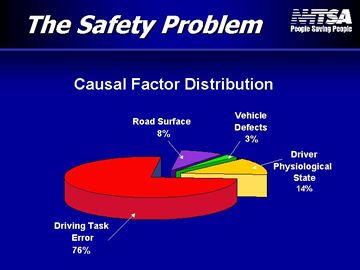
[Click on image to enlarge]
|
This slide gives the distribution of causal
factors in producing the crashes mentioned in the previous chart. It
is clearly seen that almost ¾ of the problem is due to the driving task
errors.
Other driver related causes are physiological
state of the drivers such as impairment, drowsiness or other such factors.
Vehicle defects have a small part to play
in this and so do road surface related causes.
Our approach in active safety has been
to use intelligent technologies to sense impending crashes. These technologies
provide warnings to drivers in the event of a potential crash, to nudge
them into taking appropriate preventive actions.
|
| When necessary they also provide
assistance in braking or in steering away from the road-edge or other
dangerous situations to prevent these types of crashes. |
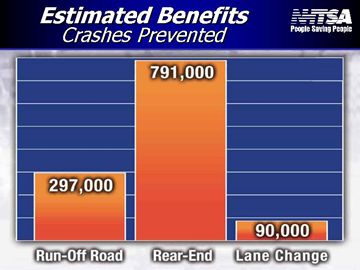
[Click on image to enlarge]
|
Based on our research and the data we have
acquired, preliminary estimates on anticipated benefits have already
been determined.
This slide show that these types of intelligent
systems could prevent over 1 million crashes a year.
However, the question remains, would these
countermeasures, when deployed fleet-wide, achieve the sharp turn upward
we need to make a dent in the problem we are trying to solve?
Would these approaches be sufficient in
accelerating the safety gains?
|
|
The answer to this question lies in what
would be the acceptable level of vehicle control the society is willing
to accept. So far we have been delicately approaching crash prevention
methods as I stated before.
That may not be sufficient. We need a
more aggressive approach. While our current methods of warning and
delicate vehicle control might be sufficient when conditions are not
anywhere near the limit, under limit conditions, we may have to move
towards some control by the vehicle.
Many drivers may find this unacceptable.
However, as we gradually move into stability control, traction control,
adaptive cruise control and other technologies, the public will slowly
get used to it, and a time will come when more and more drivers will
be willing to give up occasional control when the situation warrants
it.
But this is not going to occur fast. And
our efforts must be geared to make this happen as early as possible.
Our approach in research for developing technologies must move from
“driver-in-the loop” towards, occasional, “driver-out-of-the-loop” when
necessary.
To make our systems fool proof, there must
be test procedures developed for proper evaluation at sub-system and
system level including fleet operational tests. Specifications for
sensors and performance of algorithms must also be established and their
performance determined.
The transition from warning systems towards
vehicle control systems cannot be sudden and it has to be smooth.
The situation where a warning system is
needed or the vehicle should assume control would be determined on the
basis of what the vehicle sees as the level of the threat posed.
|
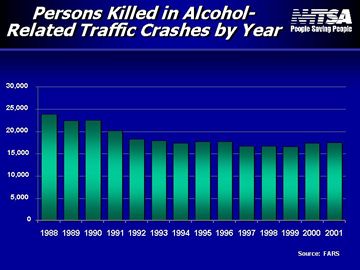
[Click on image to enlarge]
|
When we analyze our accident data we find
that total fatalities in alcohol related traffic crashes are over 40
percent.
Imagine if you will,
how well these inebriated drivers would heed crash avoidance-warning
systems?
If we had a vehicle that could determine
that the driver is incapacitated, it would be safer for the vehicle
to assume control, and that impaired driver could make it safely to
his or her destination.
|
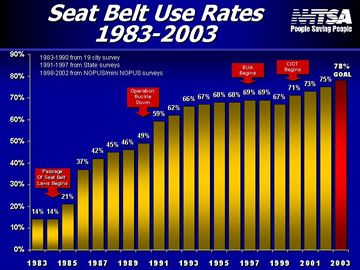
[Click on image to enlarge]
|
Our
safety belt use, even though it is continuing to increase, was at 75
percent in 2002; and we have set a goal of 78 percent in 2003.
We are continuing our best efforts in increasing
safety belt use and are currently receiving much attention on this issu.
|
| This lack of safety belt use
has allowed partial and full ejections to occur in rollover crashes.
This slide shows ejections in fatal rollover crashes for belted occupants.
They are far lower for belted occupants than for unbelted occupants. |
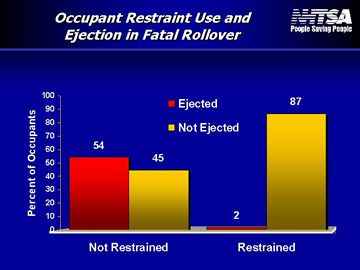
[Click on image to enlarge]
|
We have estimated that by increasing the
safety belt use to 90 percent, and devising countermeasures to address
the alcohol related safety problems—with those two approaches alone,
we could save over 9,000 lives a year.
And there is no reason why vehicle based
solutions for increasing belt use and preventing alcohol related crashes
could not be found to supplement other efforts to curb this epidemic.
|
| However, other vehicle related safety countermeasures
for preventing crashes, preventing injuries and protecting lives, could
also create significant benefits. |
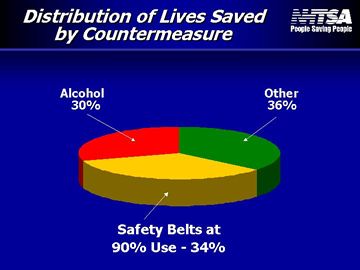
[Click on image to enlarge]
|
There are also many other problems we have
to contend with. For example, the percentage of light trucks and vans
in the fleet has been steadily increasing. They account for 50 percent
of our new vehicle sales and are currently 38 percent of the fleet.
Because of the increasing size (weight
and geometry) and stiffness of these vehicles, crash incompatibility
is of great concern.
|
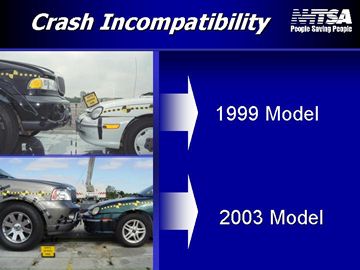
[Click on image to enlarge]
|
As you can see here, some of these larger
vehicles are more likely to be involved in rollover crashes as well.
Compare the rollover fatalities that are
occurring in passenger cars with SUV’s, pickup’s and vans. Note that
they are two to three times in pickups, vans and SUV’s in comparison
to cars.
So the problems are
multifarious.
Trying to address these problems in a piecemeal
fashion might not achieve the end result we are looking for – namely
closing this gap between the total safety need and the available safety
through countermeasures.
|
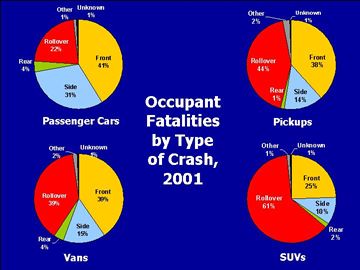
[Click on image to enlarge]
|
So what should our approach be in finding
solutions to this dilemma?
It is my humble opinion that use of advanced
technologies can go a long way towards finding the necessary solutions
for many of these problems.
However, they cannot be technologies for
technology’s sake. They must be designed to address specific problems
and at the same time be properly tested and evaluated to determine their
effectiveness.
Using technologies, every subsystem in
a vehicle must be able to communicate with every other subsystem, the
driver and the environment so that they are in total harmony while operating
the vehicle.
|
|
Imagine if you will, a vehicle sensing
the drivers’ actions and capabilities and knowing the vehicles’ own
responses and the roadway conditions, bringing into action other technologies
in the vehicle to prevent a crash.
And when necessary, instead of resorting
to “driver-in-the loop” warning system approaches, the vehicle decides
to assume control as necessary.
Should a driver be found lacking in his
capacity for safe driving, the vehicle must be able to sense that and
make adjustments in vehicle response behavior such as speed, handling,
and suspension response in the pre-crash mode.
A vehicle that senses an impending crash,
looking at the driver to sense his capacity in taking evasive actions,
and examining the traffic environment, should be able to determine whether
that crash can be avoided.
Should that not be possible, the next phase
should be an attempt to reduce the severity of the likely crash and
to prevent the injury from occurring even when the crash is at a severity
beyond the anticipated level.
The concept is, therefore, to treat the
vehicle/driver/environment as a total system dealing with the pre-crash,
crash and post-crash phases in consecutive steps.
Is that doable? I am convinced that it
can be, and some manufacturers are already moving in that direction.
Therefore, the only question is not whether we can but how, and how
fast?
Imagine if you will, a “TOTAL SAFETY” vehicle
and you are an alcohol impaired driver, not wearing the safety belt,
attempting to drive at 75 mph while keeping the vehicle under control.
To your dismay, you find that the car does
not want to get on to the highway and refuses to respond to your commands
and decides on its own what is best for you and the other occupants
for safety’s sake.
Are these concepts far fetched? Perhaps,
but with the technologies available today, we should be able to produce
such vehicles in the next two or three decades.
And only then will we be able to achieve
TOTAL SAFETY.
|
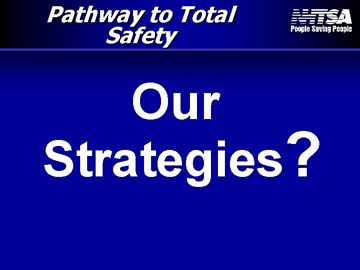
[Click on image to enlarge]
|
How do we make sure that these technologies
get deployed?
These would involve collaborative research
between suppliers, automotive industry, governments and others.
We may need legislative assistance at the
Federal and State level and empowerment of regulatory bodies to even
try these approaches.
We may have to modify the conventional
regulatory approaches to get to where we want to be and try novel methods
for standards development.
|
|
We must show what is feasible and use market
forces to achieve the results we are looking for.
Through negotiated rules, or through consensus
based and mandated standards, and through consumer information we should
be able to achieve our goal – but regulatory bodies cannot possibly
do it alone.
We need to develop suitable test and evaluation
procedures to determine the effectiveness of total systems, both with
the “driver-in-the-loop” and “driver-out-of-the loop” systems.
The governments and all other interested
parties need each other in striving to achieve a common goal. While
consensus is important, it cannot be at the cost of driving safety to
the least common denominator.
Governments’ goal should be to test as
necessary to determine the effectiveness of systems in meeting the total
safety need.
And the industry should be designing systems
that have the desired outcomes without unintended consequences while
meeting the need for consumer acceptance.
And the industry should abandon the approach
of meeting a specific test requirement at one test condition, one impact
point, and one seat position, using one dummy.
Instead, let us use intelligent countermeasures
that can adapt to a range of test speeds at different seating positions
for different size occupants, all within acceptable limits.
And let us develop a TOTAL SAFETY rating
for every vehicle taking into consideration the pre-crash, crash, and
post-crash performance expected for a range of drivers under various
driving scenarios and driving environment.
|
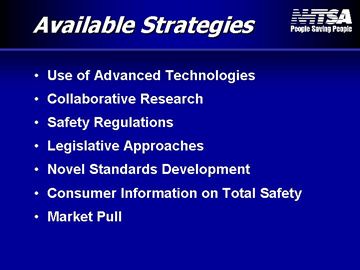
[Click on image to enlarge]
|
Solutions
Needed
I have once again reverted to the Haddon
Matrix to put down the areas that need technical solutions. Many more
items could be added here.
In all of these areas, an absolute necessity
is the data that must be collected – not using conventional means but
automatically collecting data.
The technologies are moving too fast to
use our current model of defining safety problems of the future based
on 15 year old, real world data.
We need to have predictive capability in
identifying future safety problems.
|
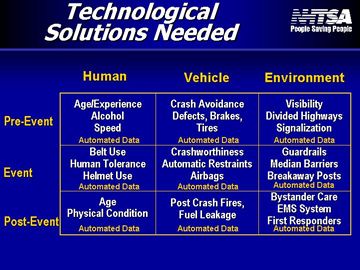
[Click on image to enlarge]
|
In conclusion, the gist of my presentation
is that technologies can solve the safety problems, provided every subsystem
is in constant communication with each other, the driver and the environment.
As a society we must learn how to relinquish
vehicle control, when we reach a stage of maturity in technology development
to trust the vehicle’s judgment
And, above all, we must have a proper means
to test and evaluate systems as a whole in meeting its promised effectiveness.
Last, we must facilitate deployment through
a variety of methods including regulations.
|
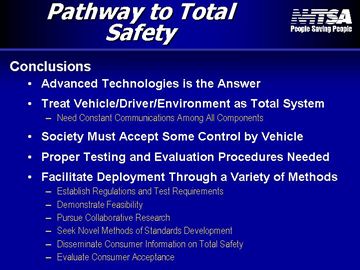
[Click on image to enlarge]
|
All of us can be proud of that day in 2030
when we have that Total Safety vehicle on the road. The technologies
are available waiting to be incorporated in to vehicle design. What
we need is a commitment from us all collectively to make it happen.
When we have closed that gap we talked
about earlier, we can rest easy. But our challenge is to accelerate
the closing of that gap in safety, and the earlier we do it, the better
off it will be for the motoring public, world-wide.
Thank you.
|
 United States Department of Transportation
United States Department of Transportation